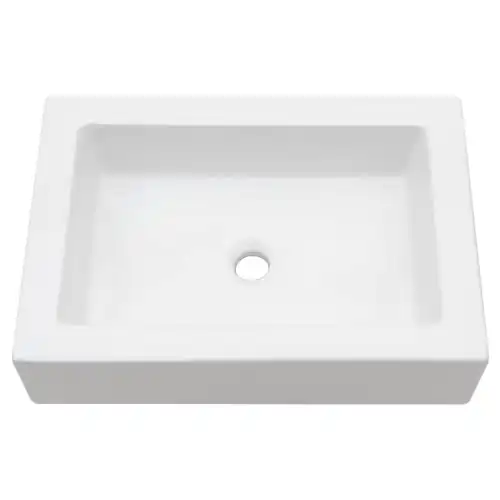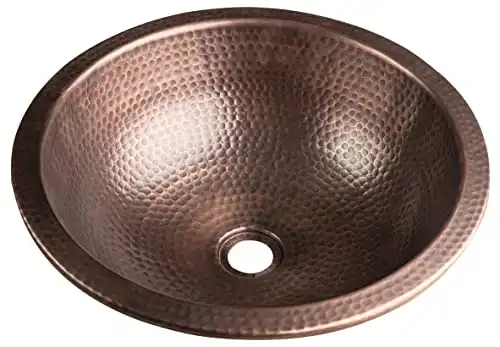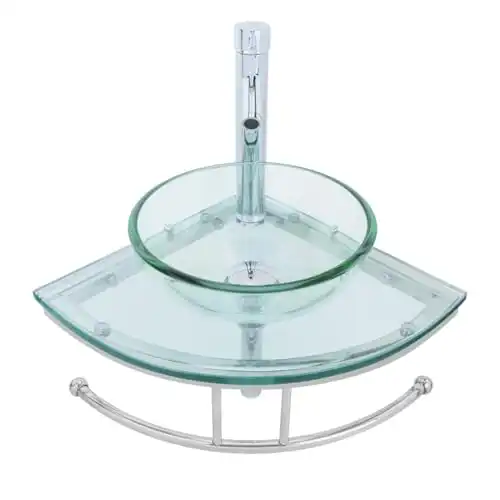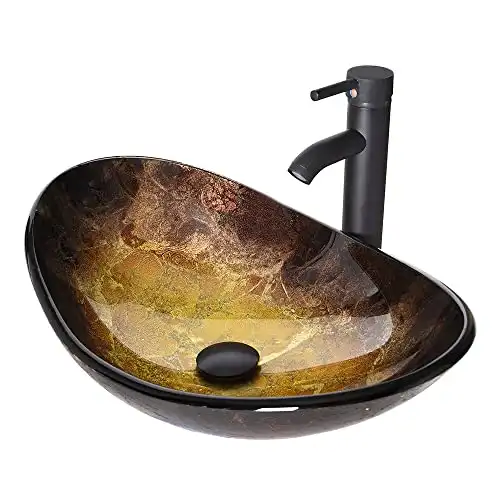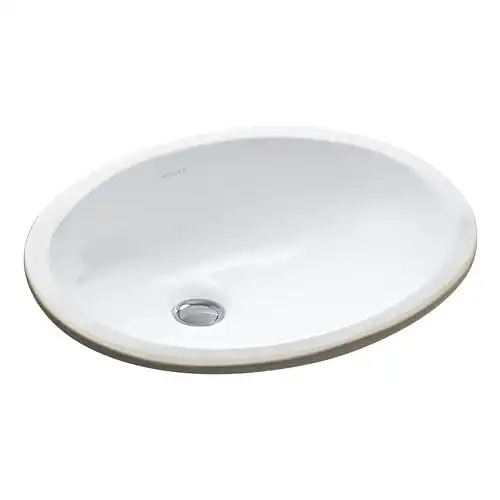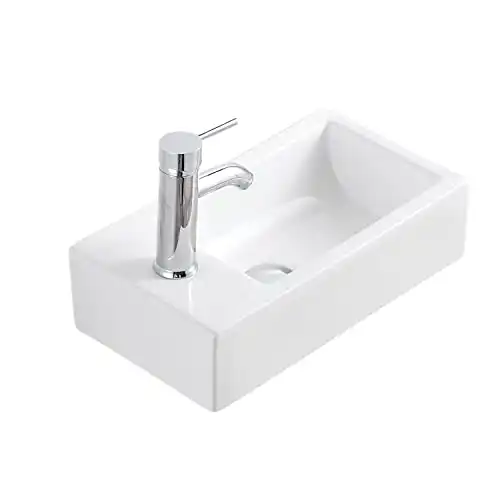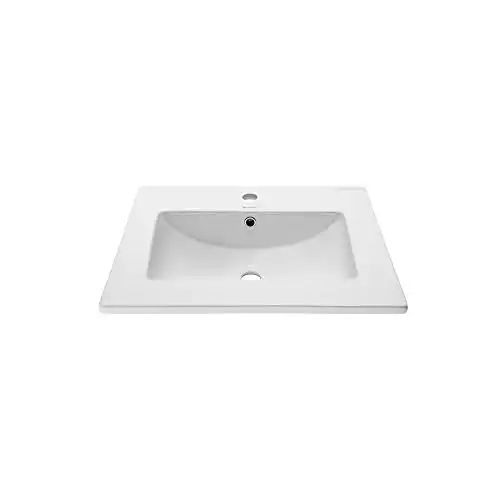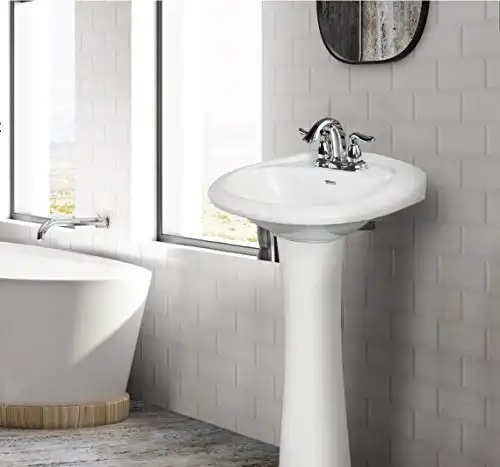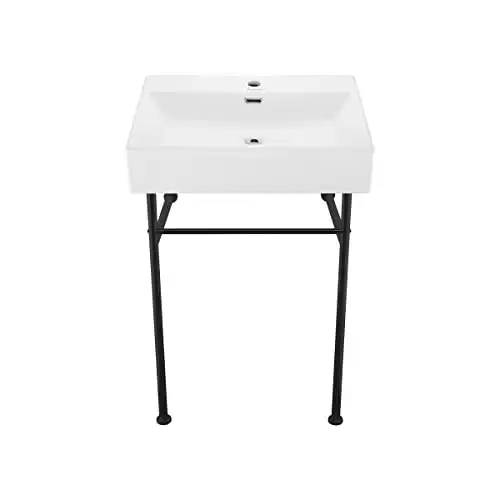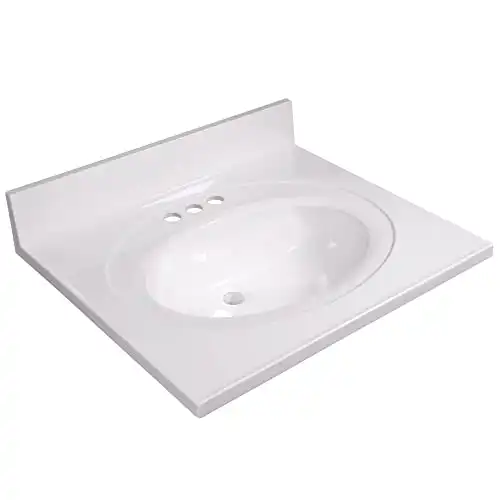When it comes to designing and furnishing a bathroom in your container home, a sink is one of the most important pieces. It’s not obscured behind a cabinet or curtain but is out in the open for everyone to see. And essentially every person visiting the bathroom will use it!
For a small container home, the style and functionality are even more crucial to get right. The right tiny home sink will have the capabilities and impressive appearance you need without overpowering the reduced space in your bathroom.
Below, we’ll show you numerous sink examples across a variety of shapes, types, and materials. Many sinks fit into more than one category, but this is just a selection of some of our favorites.
Sink Shape
The shape of a sink is primarily described by how it is seen from overhead, otherwise known as the XY plane. All the usual suspects are represented, including both organic and inorganic shapes.
However, even within the various layouts we describe below, note that there are options for different bottom shapes. Sinks can include a flat, angular, or rounded bottom, for example. But for our purposes here, let’s focus on the overhead shaps.
Rectangular Sinks
Rectangular sinks include both square and rectangular shapes, as well as troughs (long rectangles often able to accommodate two people at once). Rectangular sinks give the largest water volume capacity, for a given size and depth. However, some may find the sharp corners slightly harder to clean.
This sink is a rectangular vessel sink made of porcelain, with a simple yet modern look. Notice how shallow the sink is, which is fine for brushing teeth and washing hands but could be problematic for other uses cases.
Curved Sinks
There are a few different curved sink options, including perfectly round, oval, and even more nebulous shapes as well like the kidney-bean.
Above is a perfectly round drop-in sink with a rounded bottom made of hammered copper. Despite its artisanal appearance, it’s still quite affordable. The hammered finish means dents and scrapes will be camouflaged, but know that copper still requires some specific cleaning measures to stay looking great.
Corner Sinks
A corner sink enables alternative bathroom configurations that utilize what would otherwise be dead space in a corner. While many corner sinks actually have a somewhat triangular shape to fit snugly in a corner, that is not the only way.
This corner vessel sink is made of tempered glass for a very contemporary look that is still quite strong. While the sink itself is round, the small glass countertop it sits on fits into a corner. And while the price may seem a bit high, you have to factor in that you’re getting the sink as well as the countertop, towel rack, faucet, and drain.
Sink Type
A sink’s type is a broad description of characteristics like its visual style, mounting system, and installation method. Note that a sink can embody multiple styles, as we’ll discuss below.
Vessel Sink
Vessel sinks (also called bowl sinks) are basically bowls that sit on top of the countertop instead of being flush with them. A vessel sink raises the basin of the sink up several inches, which may be important to keep in mind if you’re designing a bathroom for children. They also sometimes require special faucets with longer necks to reach over the top of the bowl.
For those interested in repurposing furniture, vessel sinks are especially alluring. Old tables can suddenly be transformed into bathroom vanities with a bowl sink set on top.
This vessel sink is made of artistic colored glass. It has a weathered stone appearance combined with the smooth glossy finish of glass to give your bathroom an exotic look. And despite its decidedly high-end design, it’s actually priced reasonably.
Under-Mount Sink
When you’re looking for a sleek, refined look, under-mount sinks are a great choice. These sinks have no rim, edge, or border between the basin and the countertop which makes cleaning easier.
With an under-mount sink, you can choose how much ‘reveal’ you want to see by sizing the hole in the countertop slightly larger or smaller than the sink itself. You typically use a combination of adhesive and mounting brackets to hang and support the sink from the counter above.
While under-mount sinks may seem expensive, they can actually be affordable as this vitreous china finish model demonstrates. In the picture, it’s mounted with the common negative-reveal configuration so that the countertop slightly overhangs the inside of the sink.
Wall-Mount Sink
Whether you’re short on space or just want a bathroom with a less hectic appearance, a wall-mounted sink can help. Thanks to a strong attachment to the actual wall behind the sink, no support is needed beside or underneath the sink.
In turn, this means the sink floats in the room by itself without a countertop or cabinetry. The downside of most wall-mounted sinks is a lack of adjacent counter space.
While wall-mounted sinks can have various shapes and sizes, we’re specifically featuring this model which can work well in tiny house bathrooms. The smooth ceramic finish is low maintenance, and the narrow width means it barely protrudes into the room.
Drop-In Sink
These types of sinks go by two names: ‘Drop-In Sink’ describes the installation method, while ‘Top-Mount Sink’ describes the means of attachment. Either way, the sink requires a countertop for mounting.
Unlike the under-mount sink, a top-mount sink will have a rim or edge between the countertop and the basin of the sink that dirt and water have to be sponged over. However, thanks to gravity and the flange on the perimeter of the sink, it’s a bit easier to mount and install.
This vitreous china sink is a rectangular drop-in that is pretty standard for more conventional houses. It’s traditional without looking old and could make a nice addition to a container home that isn’t trying to push any design boundaries.
Pedestal Sink
A pedestal sink is simply a sink mounted on a column-like pedestal that is usually made out of the same material as the sink. The pedestal provides support for the sink but typically doesn’t include any storage. The addition of the pedestal definitely leads to a more classical look for the bathroom.
This particular pedestal sink is a bit more subdued than most, with a smooth pedestal instead of one resembling a gothic column. Made of vitreous china with a rounded shape, it’s easy to clean. Note that although the pedestal does hold the sink vertically, the sink does still mount to the wall to keep it from tipping over.
Console Sink
A console sink is somewhat similar to a pedestal sink except that it uses a frame with two or more legs for vertical support. While the pedestal supports a sink from the middle, console sinks are supported at the edges by their legs. Underneath the sink is an open area that is suitable for hanging a hand towel, but no bulk storage.
Most console sinks are relatively expensive, but this is definitely one of the cheapest we’ve seen. Still, it provides steel legs that contrast well with the glossy porcelain of the sink basin. If this color combination and structural framing work well with your design, a console sink might the perfect option.
Integrated Sink
What we’re calling an integrated sink is one that is literally part of the countertop instead of being a separate piece. They are usually cast from a composite mix, although you’ll occasionally see them hollowed out of a wood slab or made out of metal and other materials.
With the sink and counter made as one piece, there are seams or cracks to get dirty and no aligning or mounting issues between the basin and counter. However, this option does make the counter heavier.
The sink above is made from cultured marble, perhaps the most common materials for these types of sinks. While it’s a decent price, we would actually encourage you to shop locally for this type of sink. A cultured marble specialist in this area can make a sink with the exact shape and dimensions you want quite easily.
Sink Material
The last characteristic we’ll discuss is the material and finish of a sink. In many of the example sinks above you’ve seen us mention a handful of materials. Some you may recognize, others may be new. People are surprised to learn about the wide array of materials that can be used to make a sink.
And when deciding between materials, remember that your options are not only differentiated by appearance. Your choices here also impact the durability, ease of repair and cleaning, price, and other factors that we’ll discuss below.
Glass and Ceramic Sinks
This is a group with two distinct subtypes, but we’ve decided to combine them under this heading because they all generally involve materials that are fired and fused together.
Ceramic sinks are by far the most common type, and quite possibly are what you have in your bathroom right now. They are essentially a type of pottery created by forming then heating non-metallic minerals like clay.
There are several types of ceramics (and coatings for ceramics) you may see with added strength and durability including porcelain and vitreous china. In many cases, a base ceramic undergoes further firings with secondary coatings to improve its density and toughness. Additionally, some sinks are made with a porcelain enamel coating on top of a cast-iron (or other metal) base.
Glass is technically not a ceramic from a materials science perspective, although both have similar manufacturing processes and properties. Glass includes both traditional glass, the much more common tempered glass (which is far stronger for usage in a sink), as well as infinite varieties of colored glass.
The distinguishing feature of both ceramic and glass sinks is their smooth, durable finishes. This makes them long-lasting and easy to clean, a great fit for usage as a sink.
Metal Sinks
Metals sinks have a well-earend reputation for strength, but they do have some downsides. They are often easier to scratch and harder to keep clean, quickly showing soap scum, oxidation, and other discolorations. Your choice of finish will also impact how much these issues affect you as well.
While stainless steel sinks are common to see in kitchens, bathrooms typically lean toward other metals. You may see bronze, nickel, copper, and even chrome sinks occasionally.
The finishes of these metals also vary considerably. Brushed, hand-hammered, or polished finishes are some of the most common.
One other thing to note about metal sinks is noise. While you’re unlikely to be banging around dishes in your bathroom sink, just the sound of water can be annoying to some people.
Metal sinks can sometimes have a slight reverberation that leads to a loud, hollow sound when water hits them. Some sinks include a dampening or sound absorbent coating to reduce this, which may be something for you to consider
Wood and Bamboo Sinks
These natural-looking sinks give a completely different appearance to a bathroom. In most cases, wood sinks have their basin carved from a large, thick slab of wood. Bamboo sinks, conversely, are made by joining thin laminated strips of the outer sheath of the bamboo plant into the shape of a sink.
There are actually a number of tree species that can be used for wood sinks, each having varying degrees of strength and porosity. In most cases, epoxies or similar coatings are applied to the sink basin to increase water resistance and glossiness. In comparison, most bamboo sinks leave the matte finish of the raw bamboo.
Both options are quite strong and easily become the focal point of the bathroom when installed. However, they may require some special care and maintenance.
Natural Stone Sinks
Stone sinks are definitely toward the more luxurious end of the market. Unlike wood sinks, they generally can’t be made by a do-it-yourselfer either.
Instead, a factory will scrape and chisel out a basin from solid rock, then use additional tools to smooth, hone, and polish the interior of the basis. The result is often a rough finish on the outside with a smooth inside.
This contrasting appearance makes stone sinks very unique. Furthering this idea is the fact that no two stone sinks are the same because the stones they are made from are all different.
If you want a truly one of a kind sink that was literally quarried from the earth then shaped by heavy tools, a stone sink is for you. Commons minerals used for stone sinks include granite, limestone, sandstone, onyx, and marble (not to be confused with cultured marble, which we’ll touch on next).
Composite Sinks
A composite is simply a material made of two or more parts. In our case, we’re referring to a number of materials that combine polymers, acrylics, resins, epoxies, and other binders with stone fragments, powders, and dyes. Sometimes they are formed in slabs, much like how you might purchase a slab of granite for a countertop. In other cases, they are made into a wet mix that is then cast into the shape of a sink before curing and hardening.
Common composite sink options include so-called ‘solid surface’ materials like Corian, engineered stone, cement, and cultured marble. Cultured marble is especially confusing to many people, as it is actually made with marble dust and a binder. However, it is distinctly different from solid marble (a specific variety of metamorphosed limestone that we covered above in the Natural Stone Sinks section).
From a performance perspective, these man-made and semi-man-made materials have excellent properties that make them great candidates for sinks. Additionally, their ability to be cast into precise shapes leads to them being fairly economical.
Summary
Finding the perfect tiny bathroom sink to use in your container home doesn’t need to be overwhelming. And thanks to our guide and numerous examples, you should have a good idea for the look and performance you are interested in.
We hope you’ve learned about some new sink shapes, types, and materials available to you as you find the perfect fit for your container home.



